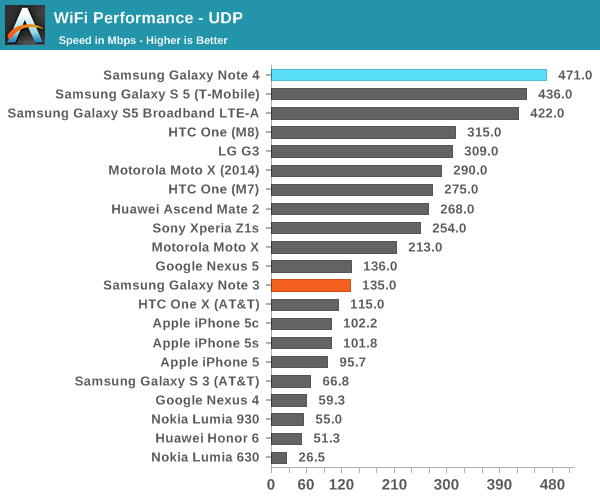The Samsung Galaxy Note 4 Review
by Joshua Ho on October 15, 2014 9:00 AM EST- Posted in
- Smartphones
- Samsung
- Android
- Mobile
- Galaxy Note 4
WiFi Performance
While the Galaxy S5 LTE-A Broadband had a Qualcomm Atheros solution (QCA6174), the Note 4 moves back to Broadcom's WiFi solution. In this case, we see the BCM4358, which is a revision of the BCM4354 that was first seen with Samsung's Galaxy S5. This shouldn't have any major differences outside of improved Bluetooth coexistence but antenna design can and does change between revisions. In order to test this, we use iperf and Asus' RT-AC68U router to try and achieve maximum performance.

As one can see, the Galaxy Note 4 has a strong showing in this test, easily surpassing every other device we have available for testing.
GNSS
At this point, it really goes without saying that the GNSS solution of choice is the one built into Qualcomm's modem. This allows for fixes based upon initial location and time data that the modem has, and therefore in practice every GPS fix is a hot fix and takes around 5 seconds for a lock in good conditions. In the case of the Note 4, with airplane mode on and no assistance data I saw that it took around 50 seconds to achieve a lock, but this is strongly dependent upon environmental conditions. Once locked, I found that the Note 4 had quite a strong lock and quickly went down to 10 foot accuracy level without issue.
Misc
Similar to the new Moto X we see a Cypress CapSense solution in the Note 4 but this is likely used for the capacitive buttons rather than any impedance-matching antenna tuner. The UV sensor appears to be a Maxim design win, although there's no information on the specific part. The battery's fuel gauge is also a Maxim part, as is the speaker amplifier and pulse sensor. The NFC chip used is NXP's PN547, so host card emulation should be supported and therefore Google Wallet's tap and pay system should work as well.











195 Comments
View All Comments
dakishimesan - Wednesday, October 15, 2014 - link
You can't ignore maximum brightness. OLED screens have a high contrast ratio because their black levels are very deep, which offsets the lower brightness to still give it a high ratio. But maximum brightness still matters for visibility outside.theduckofdeath - Wednesday, October 15, 2014 - link
You can however dismiss its importance. If the dynamic range is below the thousands on one tech and maybe above the millions on the other tech, other numbers suddenly become really, really irrelevant.JoshHo - Monday, October 27, 2014 - link
This is technically inaccurate. Outdoor visibility is primarily determined by maximum brightness and diffuse reflectance, not native contrast.jnb - Wednesday, October 15, 2014 - link
I played around with an iPhone 6 Plus and the Note 4 at Best Buy the other day. I thought there was a big difference in the display with the Note 4 being much better. It is interesting to see a review like this say there are basically equal. It goes to show that you should really look at them in person and form your own opinion. These numbers don't mean anything to an average person.melgross - Wednesday, October 15, 2014 - link
That's very misleading. While the blacks are just a small bit better than the best LCD displays, the whites are half as bright. In normal lighting, the much dimmer AMOLED displays will look fine, but outside, in direct sunlight, they will be washed out.The GS5 is definitely not more readable outside. So just go ahead and ignore reality. Brightness is directly responsible for readability outside. It's not magic.
Tams80 - Thursday, October 16, 2014 - link
It's not just brightness. I don't know what Samsung have done here, but Nokia CBD (proper CBD) increased sunlight readability without just increasing screen brightness.theduckofdeath - Thursday, October 16, 2014 - link
It's not "a small bit better", it's a much bigger difference than what you get between TN and IPS. 100's times bigger in fact.skinygeek - Wednesday, October 15, 2014 - link
Wondering how the Battery life of Exynos Variant would be . The 20nm Tech should give it an edge.danstek - Wednesday, October 15, 2014 - link
Is the graph comparing camera focus latency missing? Not showing up for me.juicytuna - Sunday, October 19, 2014 - link
It's there now, but unfortunately too late as most of the sites readership will miss out on knowing how awesomely fast the camera is.A stark contrast with the iPhone 6 review where the phase detect autofocus was put on pedestal and showered with confetti.